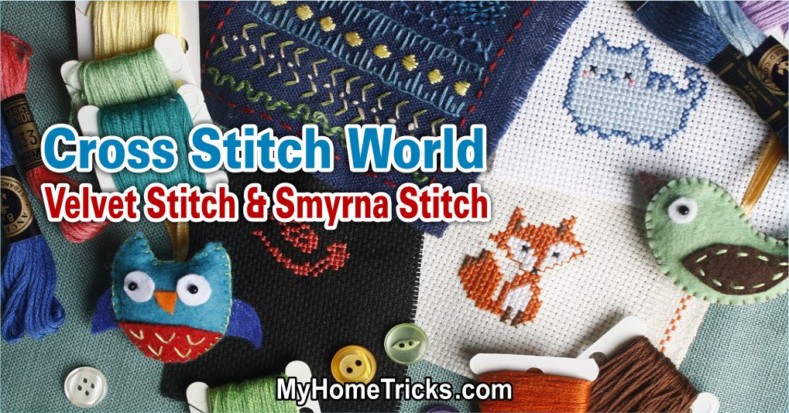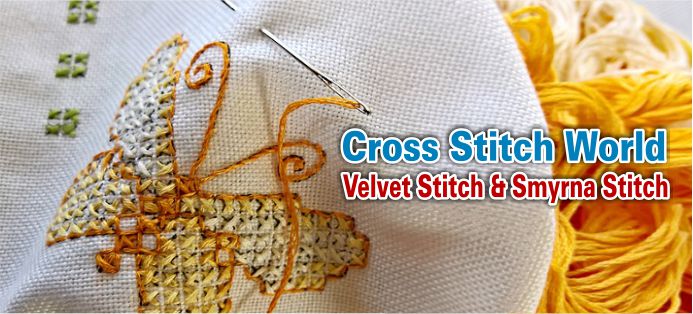Cross Stitch World
Cross Stitch World is based on cross stitch. This lovely stitch is an example of a loop, or pile, stitch. In this stitch, loops of yarn formed by the stitches create a pile on the surface of the canvas. Velvet stitch is used in embroidery as well as needlepoint. It was first seen in the reign of Charles I and was again widely used in the 18th century in Savonnerie tapestries. It became very popular in the 19th century when Victorian tufting, or plush work, was used. The main task was in a flat stitch like a tent stitch, with velvet stitch used for areas requiring high relief, such as flowers, fur, and feathers. Velvet stitch can be worked over two threads of a single canvas or over one or two (double) threads of the double canvas. It resembles boucle yarn when worked over one thread. Practice it over two threads first. The loops may be cut or left uncut.
Cross Stitch World – Velvet Stitch
- Starting at the lower left and working from left to right, make each stitch as follows. Bring the needle out at 1. Take it to the upper right over two canvas intersections and insert it at 2. Take it to the lower left under two intersections and bring it out at 3 (same hole as 1). Take it over to 4 (same hole as 2), leaving a small loop of yarn, which you hold with your left index finger. Bring it out at 5, with the point of the needle under the loop.
- Take the needle diagonally over two intersections to the upper left and insert it at 6. Bring the needle out at 7 (same hole as 5) and repeat. Begin a new row at the left. These diagrams show velvet stitch worked over two threads of a single canvas, but the same technique can be used when working it over one or two (double) threads of double canvas.
Cross Stitch World – Smyrna Stitch
Another stitch based on cross-stitch, Smyrna stitch forms a square, raised stitch that is traditionally used in the geometric patterns of stitchery.
Although Smyrna stitch is most often seen in the textural work of the 1950s and ’60s, it had a brief period of great popularity in the Victorian era, often embellished with beads. Smyrna stitch may be worked over two threads (as in the next project), three threads (as the Victorians did), or four threads. It is formed by working a basic cross stitch and then an upright cross stitch over the top. Smyrna stitch may be worked in a single color, or you can do complete stitches in alternating colors for a checkerboard pattern. For a different effect, the base cross can be worked in one color and the top one in another.
Cross Stitch World – Making Smyrna Stitch
- Starting at the upper left and working from left to right, make each stitch as follows: Bring the needle out at 1, and insert it at 2. Bring it out at 3 and insert it at 4. You now have the basic cross. Bring it out at 5 and insert it at 6. Bring it out at 7 and insert it at 8. You now have an upright cross stitch on top of the basic cross-stitch. Always follow the same sequence so that all the stitches finish with the same stitch.
- Continue in the same way to the end of the row, then work back from right to left beneath the first row. The top holes of the new row should be the same as the bottom holes of the previous row.
More:
Tip: In this article, we have discussed some basic knowledge about crafts and Cross Stitch World. For more information on these topics, you can look at the “tags” below.






